How many times do you change locations of where you work in your office? Only once or twice? Now imagine if you doubled or tripled that. Would it make you more productive?
This might sound impossible in today's fast-paced offices, but simple changes can make it a reality. Activity-based work supports the idea that employees who move to different workstations in their office are more productive. The idea is that different types of workstations such as huddle rooms, desks, and office lounges help keep employees refreshed and best suited for their specific tasks at hand.
What is Activity-Based Working?
Activity-based working is the act of moving to different workstations that support different tasks with their setups. Employees can take a call in a phone booth, work at a desk, and host a conference depending on their needs during the day.
Companies using this style of work are increasing as well. Some success stories include companies like Microsoft, who implemented activity-based work in their Amsterdam office and saw an increase in productivity of 25% while experiencing a 30% drop in real-estate costs.
When an employee comes in, they can book or move to the specific spaces they'd like to use for the day. They can start off at a desk, and reserve certain workstations for use throughout the day depending on what they need them for. Instead of one set desk, they move all over the office without setting up a home base.
Although this could come off as difficult to implement, it's not too hard! This change doesn't have to occur overnight. Think about the types of spaces you'll need (as we'll discuss later) and poll employees about what they would want to use. This gives you time to take into account what you'll need and slowly roll those options out while setting up activity-based work. This way of working might seem different, but it has results.
Activity-Based Working Benefits
Activity-based work brings huge benefits for companies that adopt it, from its employees to its bottom line.
1. Increased Employee Focus
With activity-based work, the work location is based on the needs of the employee. When they use spaces that are best suited for their tasks, they can focus on what they need to complete. If they need to do focused work, they can move to an area that supports that, without losing focus when their team around them is talking about last night's Bachelor episode. The average employee loses 2.1 hours a day to distractions, so avoiding these is key to create high-quality work.
2. Uses Resources Effectively
It's not just employees that use resources more effectively with activity-based work, but their companies as well. On the employee side, they use the resources they need depending on their type of work. Conference rooms can be dedicated to large groups rather than areas for one-on-ones because activity-based environments offer smaller meeting spaces. Employees don't have to shuffle around to new areas because every other space is in use. Every minute that's wasted looking for spaces to meet is a minute that could have been used to get work done.
Companies also benefit from activity-based working because spaces are used more efficiently. Every amount of space a company owns has a cost to it. If offices aren't the right size, it's impossible to get work done. Instead of making the jump to larger unneeded office space, activity-based work utilizes underused areas of the office. Diversifying the types of workspaces makes efficient use of resources without the square footage.
3. Keeps Employees Refreshed
Anyone who's seen Office Space knows how horrible your standard grey cubicle can be. The boring color, uniform shape, and no view of others leave people drained and bored. Without being excited or energized, people stop working and start counting down the hours until they can go home.
Activity-based work gets rid of this standard setup. Employees get to move around and work in different areas based on what they need to do. These new sights and sounds keep workers energized to get their work done. When people enjoy the work they're doing, they'll be ready to stay instead of wishing they were back at home.
4. Boosts Morale
Employee burnout can kill your company. Gallup reported that 23% of employees surveyed reported being burned out at work very often, which is 23% too high. When employees get burned out, they stop producing high-quality work and will be more likely to leave your company. Activity-based work stops this.
Unique workspaces keep employees happy and involved in their work. It allows them to work how they see fit, and combined with standard remote work policies, increases employee morale. Increased autonomy on how they want to work lets them know that your company cares about their well being. At the end of the day, who doesn't love getting the choice to work from a comfy couch, a desk in the office, or from the coffee shop down the street?
Activity-Based Working Environments
Here are some typical activity-based working environments that you might see around an office. Companies often use a combination of these workspace styles so employees can work productively no matter the task at hand.
1. Lounge Areas
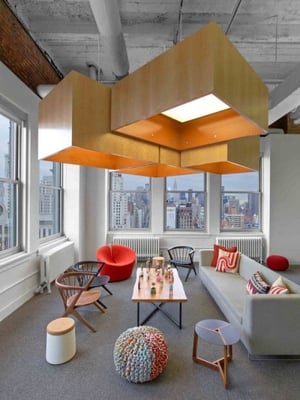
Source: Office Design Gallery
Who doesn't love to sit on a comfy couch while they work? Adding a lounge area with comfortable chairs and a couch or two creates a relaxing place to drop by and work. From checking emails to having a casual one-on-one, lounge areas make work a low-stress environment. These can be social areas for quick conversations and brainstorming. They'll also give you a place to spend a few extra minutes discussing things from your prior meeting.
2. Office Cafeterias and Kitchens
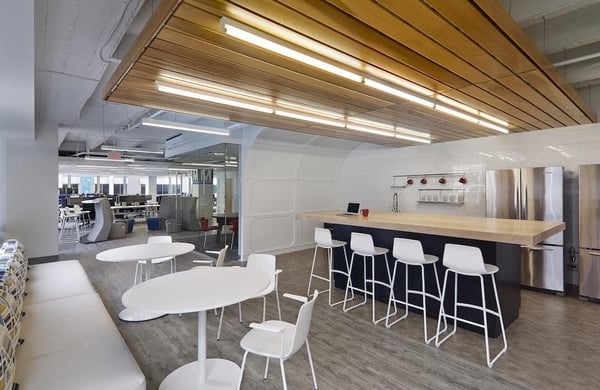
Source: AmericanInno.com
A great area to get work done is in your office kitchen. Besides being able to snag the cake from a birthday, the kitchen is a great place to get employees working. Employees can work at tables in the spot where they can see their whole office come by for a quick snack. This facilitates conversations easily. Team members can have quick discussions about projects or topics while they take a break.
Some employees will also enjoy the white noise that comes with public spaces like this. People work at places like coffee shops because they provide a comforting level of noise. You can get into your zone and work without any small sound distracting you like it would in a silent room.
3. Huddle Rooms
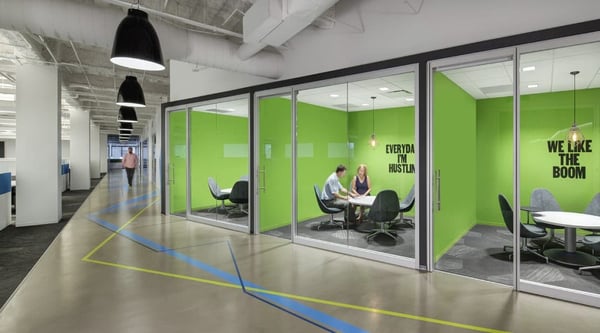
Source: IntegrateExpo
Huddle rooms are the perfect blend between a conference room and a batch of desks. Built for three to five people, a huddle room is a perfect place to have a quick and focused meeting without leaving half the room empty. The team will be more engaged with everyone close together with the equipment of a conference room (such as the Meeting Owl Pro). Huddle rooms also let employees gather a group for an impromptu meeting without having to hoard a conference room.
4. Conference Rooms
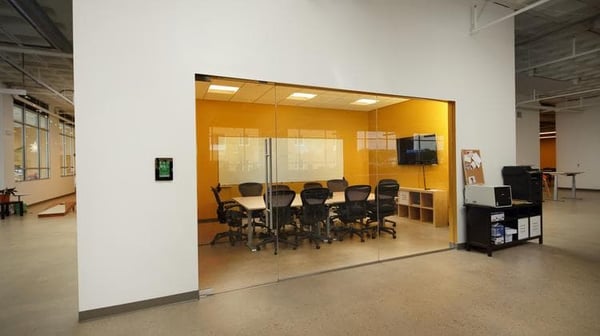
Source: BizJournals
Conference rooms are an office staple. It's too bad we use them so ineffectively! Most offices only have one or two conference rooms for the whole company, without any other working spaces described here. The conference rooms become havens for those trying to work in silence. They turn into a musical chairs situation with teams trying to find meeting spaces that don't have squatters in them.
To get rid of the headache of removing people from the room you're hosting a meeting in, utilize these other spaces. Set it up as a smart meeting room, with great video conferencing software, a 360° camera, and a smart whiteboard.
5. Singular Pods
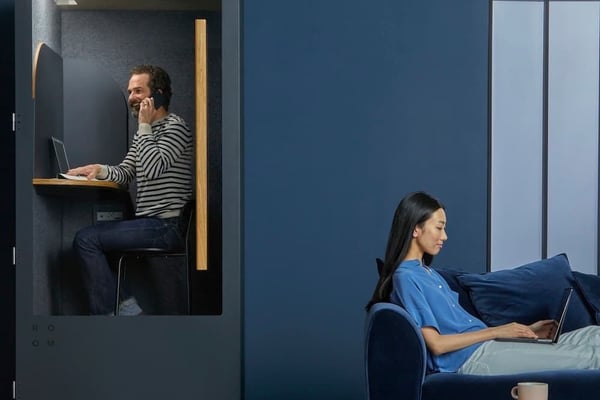
Source: Room
These singular areas are the new hot space to let individual employees work best. Booths allow individuals to work in a silent area and take calls with other employees. Instead of using a whole conference room for a ten-minute call with your colleague, you can drop by one of these booths and chat. It's a more effective use of space and silent too. You'll finally be able to avoid coworkers all making video calls at once from their desks.
6. Regular Desk Spaces

Source: CPI Business Solutions
As cool as it is to have all these unique spaces, sometimes a row of desks is what you need. Some employees need to be at their desks with specific equipment that can't move from area to area. In this case, keeping them at a desk is most efficient.
Desks are also an important part of activity-based work. Desks provide employees with space to focus on heads-down work without frills. While adding singular pods for work and calls is important, it's not always necessary to remove all standard desks. A good mix of both (along with these other spaces) is key to getting the most out of your activity-based workspace.
Looking for more? Download our smart office guide next to make your work and meeting spaces even better for employees, no matter where they work.

